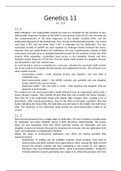Genetics 11
HC 8-9
11.1
DNA replication = the original DNA strands are used as a template for the synthesis of new
DNA strands. Important features of the DNA for this process is the AT/GC-rule, the basis for
the complementarity of the base sequences of the double stranded DNA, and the
antiparallel alignment of the double helix. This concept of directionality/polarity, one strand
runs from 5’3’ and the other from 3’5’ is important for the replication. The two
nucleotide strands of dsDNA are held together by hydrogen bonds between the bases,
however, they are easily broken. For replication, the two complementary strands of DNA
come apart and both serve as template/parental strands for the synthesis of two new DNA
strands. After separation, nucleotides have access to the template strands and form
hydrogen bonds along the AT/GC-rule. The two newly made strands are daughter strands,
but the dsDNA is half ‘old’ and half new.
So, each strand is used as a template for a new one, whereby the new helix itself consists
out of one used-to-be template strand and one new synthesised version. This is known now,
other models include:
- Conservative model = both parental strands stay together, and new helix is
completely new.
- Semi-conservative model = the dsDNA contains one parental and one daughter
strand, which is the correct model.
- Dispersive model = the new helix is mixed – both parental and daughter cells are
apparent in both strands.
The evidence for the semi-conservative model followed from an experiment which used a
heavy nitrogen isotope. They started off with DNA that fully included the heavy nitrogen,
then they let it be synthesised along with regular light nitrogen DNA, creating a lot of
generations. After several generations, they let the DNA run through a gradient: they had
bands indicating the heavy DNA, the light DNA and one band in the middle, the half-heavy
DNA. The existence of the half-heavy band proved the semi-conservative model to be
correct,
11.2
Bacterial chromosomes have a single origin of replication. The site is needed a starting point
for replication and when initiated, moves in both directions, bidirectionally. This means
there are two replication forks (site where parental strands are separated, and new
daughter strands are formed). Because the chromosome is circular, the two replication forks
meet, and replication is completed/terminated.
Within the origin of chromosome replication, oriC, there are several essential DNA
sequences found:
- DnaA-boxes binding site for initiation proteins, DnaA proteins. They bind to
several boxes and other proteins once again bind to them, causing the DNA to bend
around the protein complex and thus separating in the nearby AT rich regions.
Moreover, they recruit DNA helicase which – when it encounters dsDNA – breaks the
H-bonds between strands generating two single ones. DNA helicase kicks off in the





